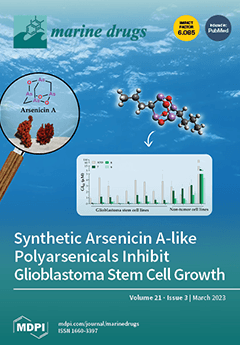In the study, papain was chosen from five proteases to hydrolyze proteins of monkfish swim bladders for effectively utilizing monkfish (
Lophius litulon) processing byproducts, and the hydrolysis conditions of papain were optimized as hydrolysis temperature of 65 °C, pH 7.5, enzyme dose 2.5% and time 5 h using single-factor and orthogonal experiments. Eighteen peptides were purified from the swim bladder hydrolysate of monkfish by ultrafiltration and gel permeation chromatography methods and identified as YDYD, QDYD, AGPAS, GPGPHGPSGP, GPK, HRE, GRW, ARW, GPTE, DDGGK, IGPAS, AKPAT, YPAGP, DPT, FPGPT, GPGPT, GPT and DPAGP, respectively. Among eighteen peptides, GRW and ARW showed significant DPPH· scavenging activities with EC
50 values of 1.053 ± 0.003 and 0.773 ± 0.003 mg/mL, respectively; YDYD, QDYD, GRW, ARW and YPAGP revealed significantly HO· scavenging activities with EC
50 values of 0.150 ± 0.060, 0.177 ± 0.035, 0.201 ± 0.013, 0.183 ± 0.0016 and 0.190 ± 0.010 mg/mL, respectively; YDYD, QDYD, ARW, DDGGK and YPAGP have significantly
scavenging capability with EC
50 values of 0.126 ± 0.0005, 0.112 ± 0.0028, 0.127 ± 0.0002, 0.128 ± 0.0018 and 0.107 ± 0.0002 mg/mL, respectively; and YDYD, QDYD and YPAGP showed strong ABTS
+· scavenging ability with EC
50 values of 3.197 ± 0.036, 2.337 ± 0.016 and 3.839 ± 0.102 mg/mL, respectively. YDYD, ARW and DDGGK displayed the remarkable ability of lipid peroxidation inhibition and Ferric-reducing antioxidant properties. Moreover, YDYD and ARW can protect Plasmid DNA and HepG2 cells against H
2O
2-induced oxidative stress. Furthermore, eighteen isolated peptides had high stability under temperatures ranging from 25–100 °C; YDYD, QDYD, GRW and ARW were more sensitive to alkali treatment, but DDGGK and YPAGP were more sensitive to acid treatment; and YDYD showed strong stability treated with simulated GI digestion. Therefore, the prepared antioxidant peptides, especially YDYD, QDYD, GRW, ARW, DDGGK and YPAGP from monkfish swim bladders could serve as functional components applied in health-promoting products because of their high-antioxidant functions.
Full article






